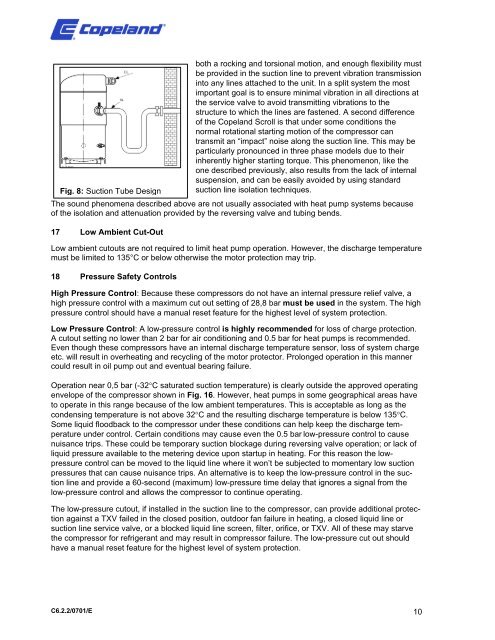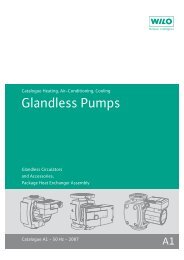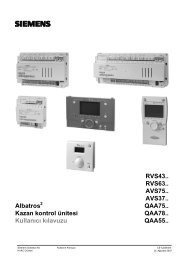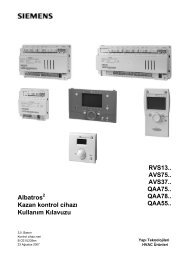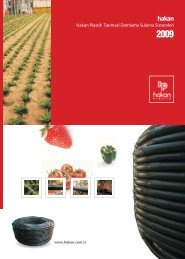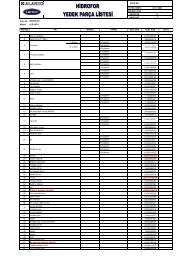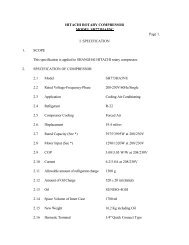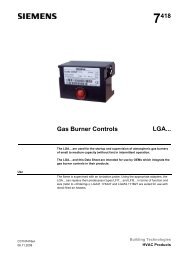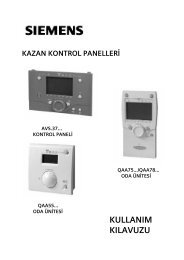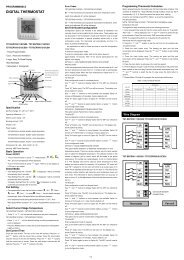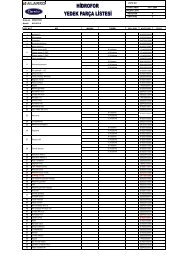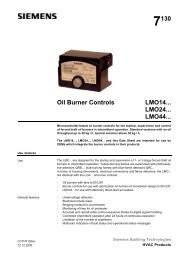A/C Scroll Compressors ZR 90 K4*.....ZR 300 KC*
A/C Scroll Compressors ZR 90 K4*.....ZR 300 KC*
A/C Scroll Compressors ZR 90 K4*.....ZR 300 KC*
Create successful ePaper yourself
Turn your PDF publications into a flip-book with our unique Google optimized e-Paper software.
Fig. 8: Suction Tube Design<br />
both a rocking and torsional motion, and enough flexibility must<br />
be provided in the suction line to prevent vibration transmission<br />
into any lines attached to the unit. In a split system the most<br />
important goal is to ensure minimal vibration in all directions at<br />
the service valve to avoid transmitting vibrations to the<br />
structure to which the lines are fastened. A second difference<br />
of the Copeland <strong>Scroll</strong> is that under some conditions the<br />
normal rotational starting motion of the compressor can<br />
transmit an “impact” noise along the suction line. This may be<br />
particularly pronounced in three phase models due to their<br />
inherently higher starting torque. This phenomenon, like the<br />
one described previously, also results from the lack of internal<br />
suspension, and can be easily avoided by using standard<br />
suction line isolation techniques.<br />
The sound phenomena described above are not usually associated with heat pump systems because<br />
of the isolation and attenuation provided by the reversing valve and tubing bends.<br />
17 Low Ambient Cut-Out<br />
Low ambient cutouts are not required to limit heat pump operation. However, the discharge temperature<br />
must be limited to 135°C or below otherwise the motor protection may trip.<br />
18 Pressure Safety Controls<br />
High Pressure Control: Because these compressors do not have an internal pressure relief valve, a<br />
high pressure control with a maximum cut out setting of 28,8 bar must be used in the system. The high<br />
pressure control should have a manual reset feature for the highest level of system protection.<br />
Low Pressure Control: A low-pressure control is highly recommended for loss of charge protection.<br />
A cutout setting no lower than 2 bar for air conditioning and 0.5 bar for heat pumps is recommended.<br />
Even though these compressors have an internal discharge temperature sensor, loss of system charge<br />
etc. will result in overheating and recycling of the motor protector. Prolonged operation in this manner<br />
could result in oil pump out and eventual bearing failure.<br />
Operation near 0,5 bar (-32°C saturated suction temperature) is clearly outside the approved operating<br />
envelope of the compressor shown in Fig. 16. However, heat pumps in some geographical areas have<br />
to operate in this range because of the low ambient temperatures. This is acceptable as long as the<br />
condensing temperature is not above 32°C and the resulting discharge temperature is below 135°C.<br />
Some liquid floodback to the compressor under these conditions can help keep the discharge temperature<br />
under control. Certain conditions may cause even the 0.5 bar low-pressure control to cause<br />
nuisance trips. These could be temporary suction blockage during reversing valve operation; or lack of<br />
liquid pressure available to the metering device upon startup in heating. For this reason the lowpressure<br />
control can be moved to the liquid line where it won’t be subjected to momentary low suction<br />
pressures that can cause nuisance trips. An alternative is to keep the low-pressure control in the suction<br />
line and provide a 60-second (maximum) low-pressure time delay that ignores a signal from the<br />
low-pressure control and allows the compressor to continue operating.<br />
The low-pressure cutout, if installed in the suction line to the compressor, can provide additional protection<br />
against a TXV failed in the closed position, outdoor fan failure in heating, a closed liquid line or<br />
suction line service valve, or a blocked liquid line screen, filter, orifice, or TXV. All of these may starve<br />
the compressor for refrigerant and may result in compressor failure. The low-pressure cut out should<br />
have a manual reset feature for the highest level of system protection.<br />
C6.2.2/0701/E 10


